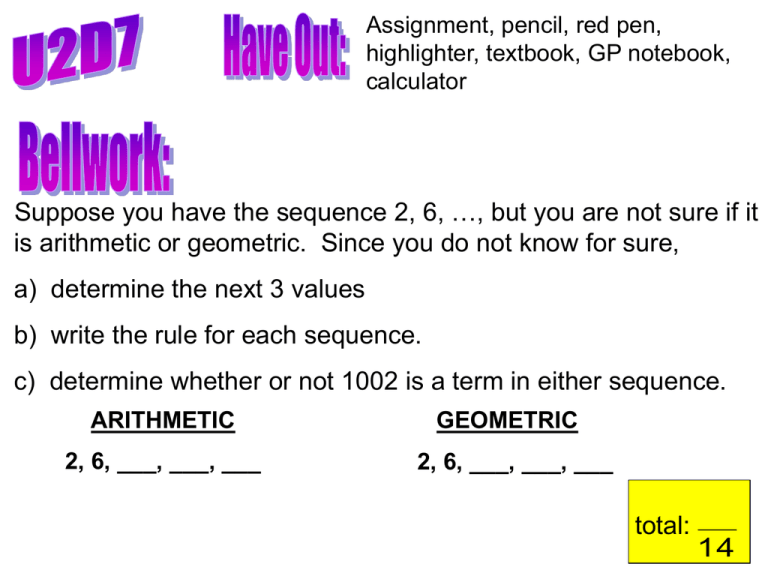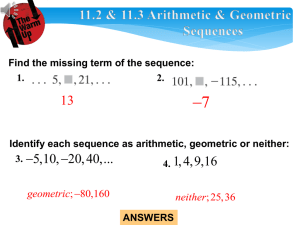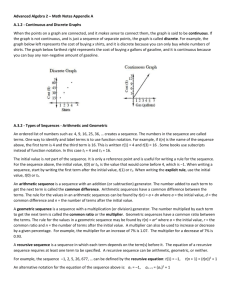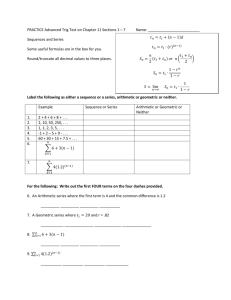Algebra 2
advertisement

Assignment, pencil, red pen, highlighter, textbook, GP notebook, calculator Suppose you have the sequence 2, 6, …, but you are not sure if it is arithmetic or geometric. Since you do not know for sure, a) determine the next 3 values b) write the rule for each sequence. c) determine whether or not 1002 is a term in either sequence. ARITHMETIC 2, 6, ___, ___, ___ GEOMETRIC 2, 6, ___, ___, ___ total: 14 Suppose you have the sequence 2, 6, …, but you are not sure if it is arithmetic or geometric. Since you do not know for sure, a) determine the next 3 values total: b) write the rule for each sequence. 14 c) determine whether or not 1002 is a term in either sequence. ARITHMETIC GEOMETRIC +1 10 ___, 18 54 18 +1 14 ___ 2, 6, ___, 2, 6, ___, ___, 162 ___ , 486 , 1458 t(n) = 4n + 2 +2 1002 = 4n + 2 +1 1000 = 4n 250 = n +1 Yes, 1002 is a term in the sequence since n is a positive, whole number. +2 t(n) = 2 (3)n +2 No, 1002 is +1 not part of the sequence. +2 1002 = 2(3)n 2 2 501 = (3)n +1 We cannot solve this equation… yet. In the meantime, expand the sequence to see if 1002 is part of it. BB – 73 Consider the sequence 3, 6, 12, 24, … a) What kind of sequence is it? How is it generated? The sequence is geometric since the generator is “multiply by 2.” b) Pairing the values in the sequence with their position in the sequence creates the table below. Copy the table and continue it to include the next five terms of the sequence. n t(n) 0 3 1 6 2 12 3 24 4 5 6 7 8 48 96 192 384 768 c) How many times do we multiply the initial value of 3 by 2 in order to obtain the value of 24 in the sequence? 24 = 3 2 2 2 We multiply by 2 three times. d) Is there a short cut for doing repeated multiplication? What is it? Yes, the shortcut is using exponents. BB – 73 n t(n) Consider the sequence 3, 6, 12, 24, … 0 3 1 6 2 12 3 24 4 5 6 7 8 48 96 192 384 768 e) The value found when n = 6 can be obtained by multiplying 3 2 2 2 2 2 2. Rewrite this expression using exponents. 3 (2)6 f) What will the representation be for the hundredth term of the sequence? 3 (2)100 g) How could you represent t(n)? t(n) = 3 (2)n BB – 74 A tank contains 8000 liters of water. Each day, one–half of the water in the tank is removed. Make a table and fill in the first 5 terms and identify whether this is an arithmetic or geometric sequence. What is the generator? n 0 1 t(n) 8000 4000 2 3 2000 1000 This is a geometric sequence. 4 5 500 250 The generator is multiply by ½. How much water will be in the tank after: a) the 6th b) the 12th c) the nth day? 6 t (6) 8000 1 125 liters remain by the 6th day. 2 12 day? t (12) 8000 1 1.95 liters remain by the 12th day. 2 day? t (n) 8000 1 2 n Multiplier The number by which you multiply in order to increase (or decrease) something by a given percentage in one step. The ECHS cafeteria increased the cost of its $2.25 sandwiches by 60%. What is the new price? 100% What percentage represents the original, “whole” cost? _______ Add the percent increase of 60% to the “whole”: 100% + 60% 160% 1.60 Change the percent to a decimal. This is the MULTIPLIER: _______ $2.25 (1.60) = $3.60 Determine the new cost. ___________________ The sandwiches now cost $3.60. Determine the multiplier for each example. a) 20% mark–up on books 100% + 20% 120% 1.20 c) 47% increase in profit 100% + 47% 147% 1.47 e) 15% decrease in productivity 100% – 15% 0.85 85% b) 13.5% increase in bacteria population 100.0% + 13.5% 1.135 113.5% d) 8.25% sales tax in Los Angeles 100.00% + 8.25% 108.25% 1.0825 f) 30% off sale at Sears 100% – 30% 0.70 70% BB – 75 Newspaper Headline: FLU EPIDEMIC HITS TEXAS TOWN! 30% increase in cases reported this week! Today there were 100 cases reported to begin the annual flu season. Make a table for this sequence. n t(n) 0 1 2 3 4 100 130 169 220 286 … n a) Represent the current percentage of cases in decimal form. 100% 1.00 (We always start with 100%.) b) Change the 30% increase to a decimal. 30% 0.30 c) To increase something by 30%, we will use the MULTIPLIER: 1.00 + 0.30 = 1.30 d) Fill in the table and find a rule for the number of cases for the nth week. 100(1.3)n t(n) = 100(1.3)n







